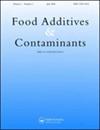Simultaneous determination of eight Polycyclic Aromatic Hydrocarbons and six Polychlorinated Biphenyls in canned sardines and human health risk.
IF 2.5
3区 农林科学
Q2 CHEMISTRY, APPLIED
Food additives & contaminants. Part B, Surveillance
Pub Date : 2025-06-23
DOI:10.1080/19393210.2025.2518075
引用次数: 0
Abstract
The present study aimed to quantify the levels of eight marker PAHs and six indicator PCBs in canned sardine fish using the QuEChERS (fast, easy, cheap, effective, resistant, and safe) method and gas chromatography/mass spectrometry (GC-MS/MS). Recoveries of PAHs and PCBs varied from 62% to 120% and 82% to 103% respectively, with a maximum relative standard deviation of 12.2%. Raw sardine contained BaP, PAH8, and Σ6PCBs levels of 4.07 ± 0.30 µg/kg, 23.3 ± 0.55 µg/kg, and 7.19 ± 0.15 µg/kg, respectively. Levels of PAH8 and Σ6PCBs in canned sardine fish varied from
沙丁鱼罐头中8种多环芳烃和6种多氯联苯的同时测定及其对人体健康的危害。
采用快速、简便、廉价、有效、耐药、安全的QuEChERS方法和气相色谱/质谱联用技术(GC-MS/MS)对沙丁鱼罐头中8种标记多环芳烃和6种指示多氯联苯进行了定量分析。多环芳烃和多氯联苯的回收率分别为62% ~ 120%和82% ~ 103%,最大相对标准偏差为12.2%。生沙丁鱼的BaP、PAH8和Σ6PCBs含量分别为4.07±0.30µg/kg、23.3±0.55µg/kg和7.19±0.15µg/kg。沙丁鱼罐头中PAH8和Σ6PCBs的含量从
本文章由计算机程序翻译,如有差异,请以英文原文为准。
求助全文
约1分钟内获得全文
求助全文
来源期刊
CiteScore
5.30
自引率
10.30%
发文量
37
审稿时长
2.7 months
期刊介绍:
Food Additives & Contaminants: Part B publishes surveillance data indicating the presence and levels of occurrence of designated food additives, residues and contaminants in foods, food supplements and animal feed. Data using validated methods must meet stipulated quality standards to be acceptable and must be presented in a prescribed format for subsequent data-handling.
Food Additives & Contaminants: Part B restricts its scope to include certain classes of food additives, residues and contaminants. This is based on a goal of covering those areas where there is a need to record surveillance data for the purposes of exposure and risk assessment.
The scope is initially restricted to:
Additives - food colours, artificial sweeteners, and preservatives;
Residues – veterinary drug and pesticide residues;
Contaminants – metals, mycotoxins, phycotoxins, plant toxins, nitrate/nitrite, PCDDs/PCFDs, PCBs, PAHs, acrylamide, 3-MPCD and contaminants derived from food packaging.
Readership: The readership includes scientists involved in all aspects of food safety and quality and particularly those involved in monitoring human exposure to chemicals from the diet.
Papers reporting surveillance data in areas other than the above should be submitted to Part A . The scope of Part B will be expanded from time-to-time to ensure inclusion of new areas of concern.

 求助内容:
求助内容: 应助结果提醒方式:
应助结果提醒方式:


